The Prime Video Series A League of Their Own, inspired by a 1992 film by the same name, tells the story of the All-American Girls Professional Baseball League, a real thing that existed in the Midwest between 1943 and 1954. Initially founded by famed chewing gum man Phillip Wrigley (owner of Wrigley Field, home to the Chicago Cubs), the league attempted to address a few interconnected issues. As emphasized in the film and TV show, Major League ballplayers were enlisting and thus thinning the ranks and starpower of their teams, and league owners were panicking about how to maintain love for America’s National Pastime during this slump. But there were other reasons, too. Minor League teams were so depleted by the war effort that many had to shut down entirely, a loss compounded by the fact that war-sanctioned travel restrictions were in place that made it tougher for fans outside of large cities to attend Major League games. Meanwhile, scores of war-related factory workers and their families in mid-size industrial cities like Rockford, Illinois, were in need of wholesome American evening entertainment to distract them from the woes of the era. And finally, women’s softball was actually already pretty f*cking popular, which we’ll talk about more in a minute. Thus the AAGPBL was born.
But how much of Prime Video’s League of Their Own is based on true stories, and which elements slightly revise the historical record? That is what we’ll be discussing today in this herstorical deep dive into the All-American Girls Professional Baseball League, softball and baseball leagues for Black players, and lesbian culture in the 1940s.
The All-American Girls Professional Baseball League Actually Started Out as a Softball League
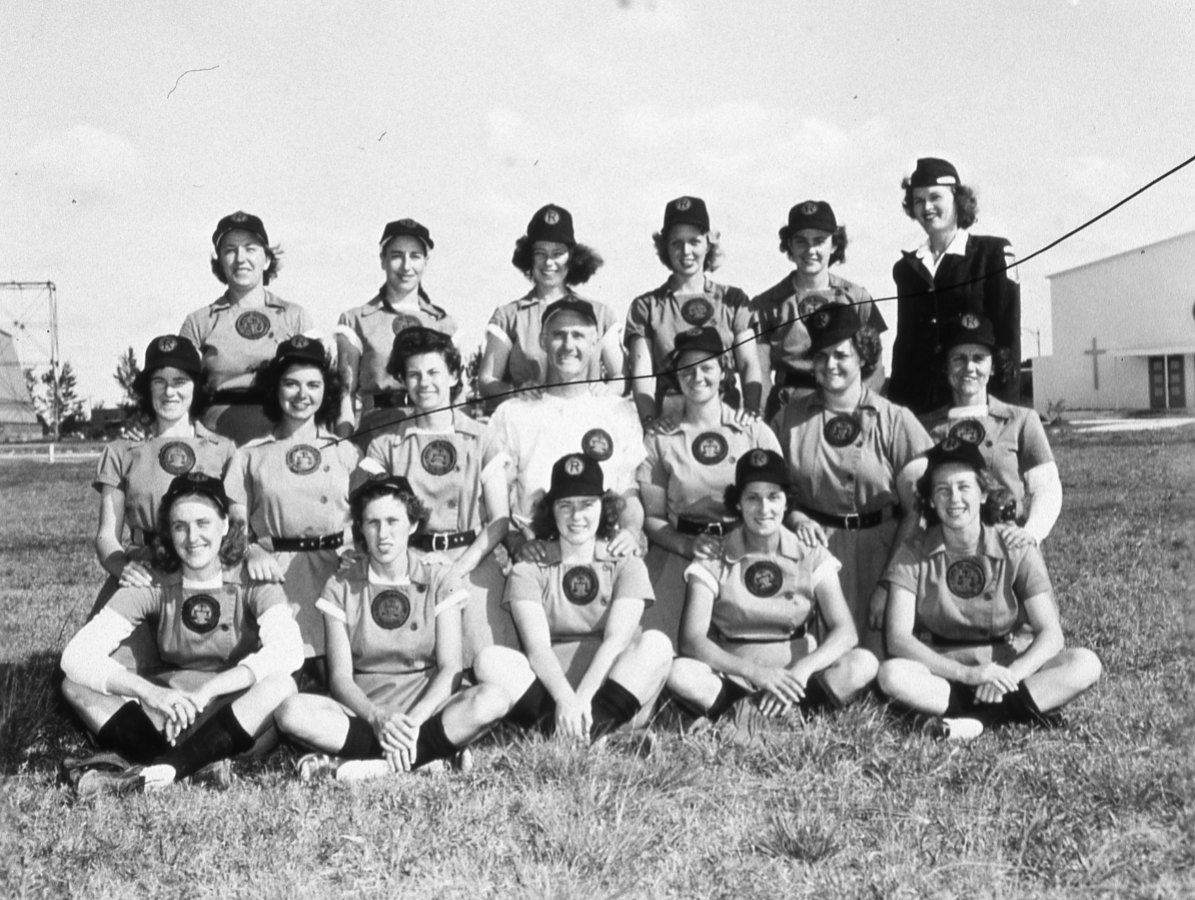
ROCKFORD, ILLINOIS – 1944. The Rockford Peaches of the All American Girls Baseball League pose for a team portrait at home in 1944. (Photo by Mark Rucker/Transcendental Graphics, Getty Images)
Although the show portrays the girls playing baseball from the jump, that wasn’t the case — they were mostly softball players recruited from local softball teams to play softball! Softball was an enormously popular American sport starting in the late 1880s, with hundreds of thousands of players joining teams in leagues all over the continent. By 1942, over 200,000 men’s and women’s softball teams existed in the country (including teams at all-women’s college), and local leagues attracted sizeable followings, including a beloved well-attended Chicago women’s softball league that inspired journalist Herb Graffis to note at the time that “it has been no secret to sports fans in the Midwest that girls’ softball in Chicago has been outdrawing the major league baseball clubs.”
Therefore, when the AAGPBL launched in 1943, it was originally called The All-American Girls Softball League. Some rules were shifted away from softball’s to increase the excitement of the game: the ball was slightly smaller, pitching distance was enlarged, base-stealing was permitted and the game lasted nine innings rather than softball’s seven — rule changes that inspired them to switch out “Softball” for “Baseball” in the league name mid-season, but not enough changes to prevent it from being changed from “Baseball” to “Ball” for its second season. Over the years, more rule changes and league name changes were made to keep the games exciting until it did become actual baseball and was named accordingly. This shift proved especially challenging for pitchers who’d honed their skills pitching underhand, and added a layer of difficulty to player recruitment.
The All-American Girls Baseball League Was a Midwestern Enterprise
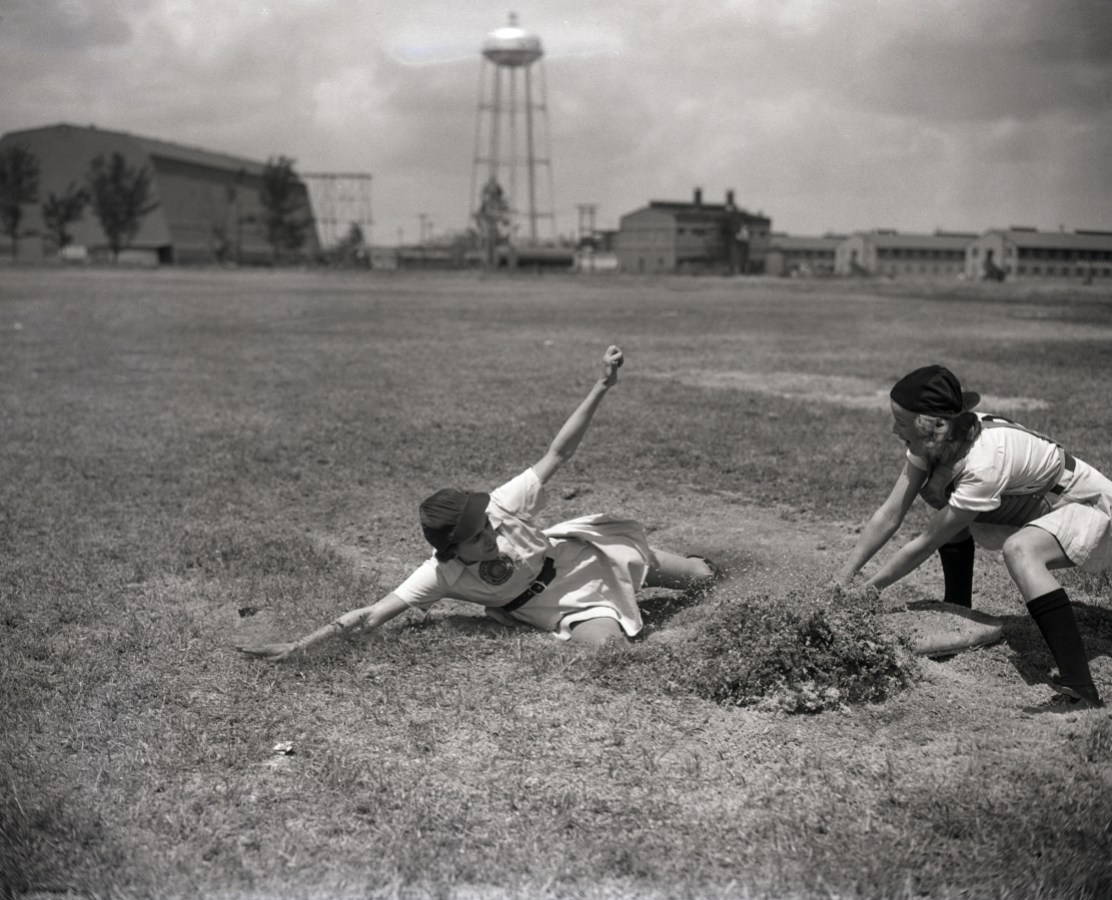
Opa Locke, FL: Sophie Kurys of Flint, MI, member of the Grand Rapids, MI, Chiks, demonstrates her sliding ability during spring training here for teams of the All-American Girls Baseball League. She was the league’s base-stealing champ last year. Covering the plate is Ruth Lessing of San Antonio, TX, Chicks’ catcher.
As portrayed accurately in the show, the league drew its players from all over the U.S, Canada and Cuba; but its teams were all headquartered in Illinois, Wisconsin, Indiana and Michigan, close enough to one another for away games to conform to wartime gas rationing restrictions. At times the league attempted to break into big cities, like Chicago and Minneapolis, but women’s baseball didn’t catch on there as it did in mid-size towns like Rockford, Kenosha, Racine, Muskegon and South Bend. Rockford was an industrial powerhouse, with many factories contributing to the war effort, and Rockford was also home to the military base of Camp Grant.
As addressed in the intro, these cities all had bustling populations of workers who were depressed about the war and death, and Wrigley was certain that women’s professional baseball was precisely the sort of wholesome family entertainment these workers should be enjoying in their off hours.
Did the Players All Live Together?
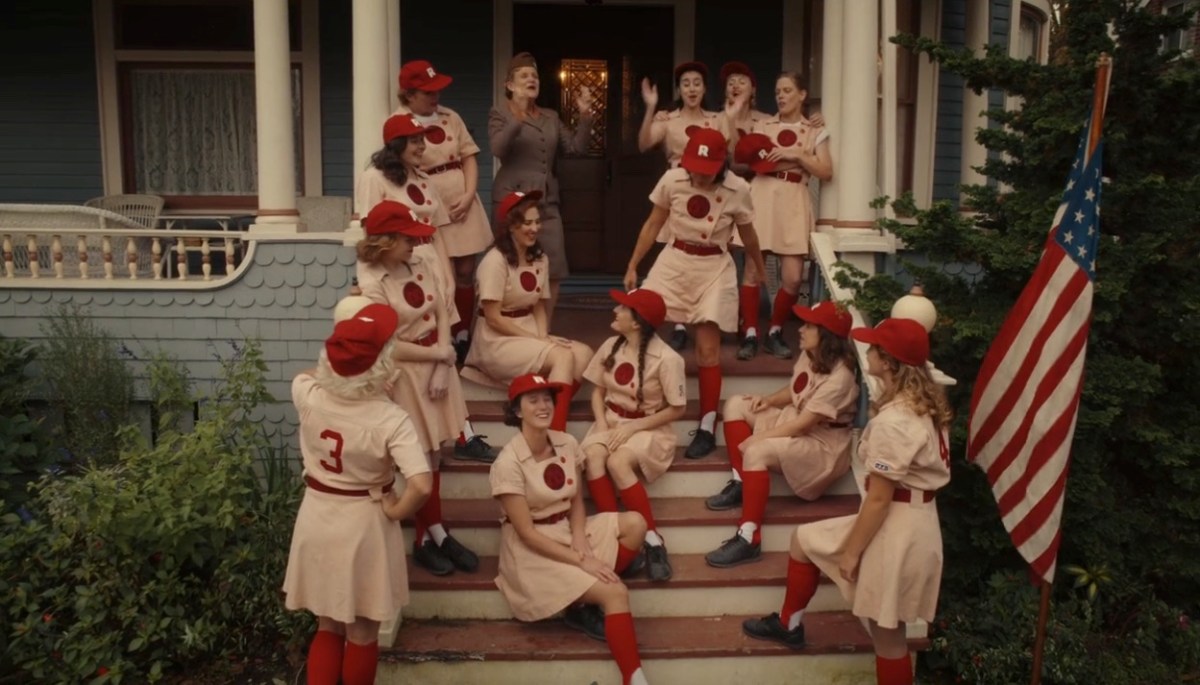
While the “entire team living in the same house” dynamic was necessary to create the human dramas portrayed in the show, in truth the girls usually boarded individually or in small groups with local families to “further enhance the clean-cut image” they were meant to portray. While playing away games, they’d sometimes room in boarding houses and sometimes at-home players would occupy a group home, but in general we did not get the delightful dormitory lifestyle the film and show portrayed.
Did Black Women Play in the All-American Girls Professional Baseball League?
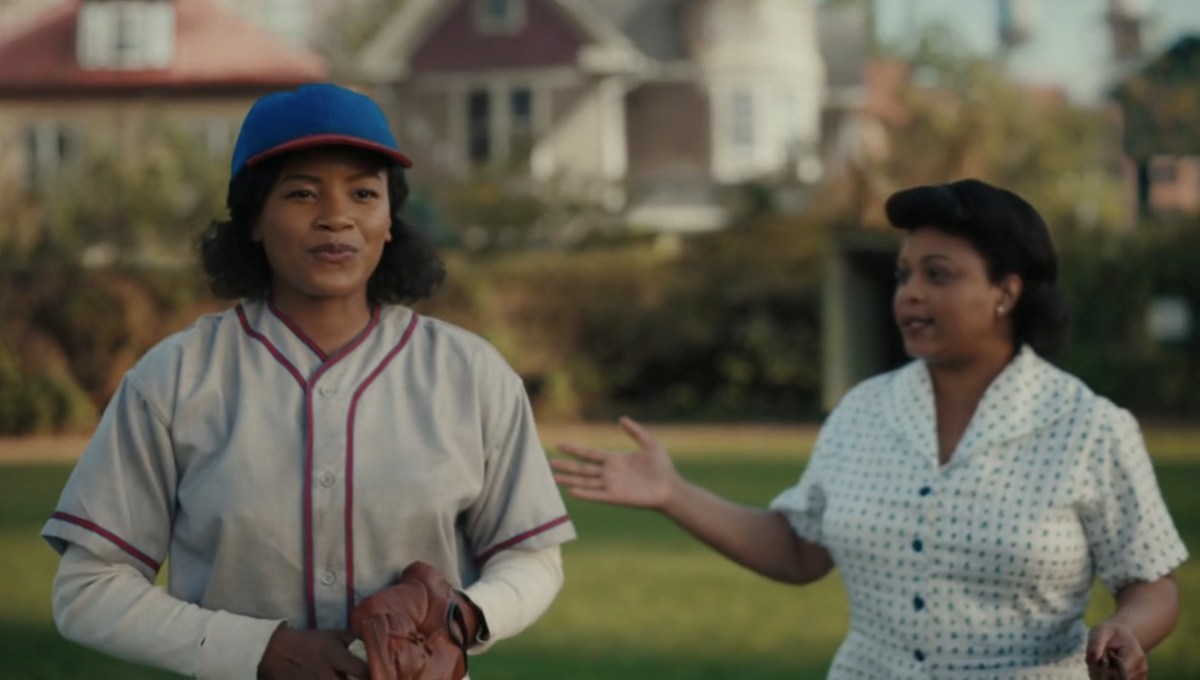
As portrayed in the show, the AAGPBL refused to allow Max, a Black woman, to try out for a spot in the league. But in 1947, Jackie Robinson broke the baseball color line and in the ensuing years, the Major League’s shift towards racial integration caused the question to come up again for AAGPBL owners. Unfortunately, they maintained their intolerance! Firstly, they argued it was already difficult enough to generate interest for women playing baseball, let alone Black women. Secondly, they claimed it’d definitely be difficult to find qualified baseball players as most Black women played softball — but this was also true of white women, so that was simply the same “we can’t find any” shit that employers say to this very day. Their third reason was, as hinted at in the show, they did not consider Black women to fit into the narrow “All-American” feminine standards they imposed on their players, rooted in the ideals of white-middle class respectability. According to Coming On Strong, in 1951 they decided against recruiting Black players “unless they would show promise of exceptional ability,” but made no efforts to attract or find any, and a Black female player who’d later join the Negro Leagues (more on that in a second) was told she was unwelcome when she showed up for AAGPBL tryouts in 1953.
Thwarted by her experience at AAGPBL tryouts, Max agrees to get a job at her local factory to potentially play for their team, as (accurately at the time) most local softball and baseball leagues were organized around workplaces. Max and Clance working at the factory is also realistic — Black “Rosie the Riveters” indeed joined the wartime factory ranks, many traveling great distances for jobs that offered unprecedented (but temporary) economic opportunities.
Were Black Women Allowed In the Negro Leagues?
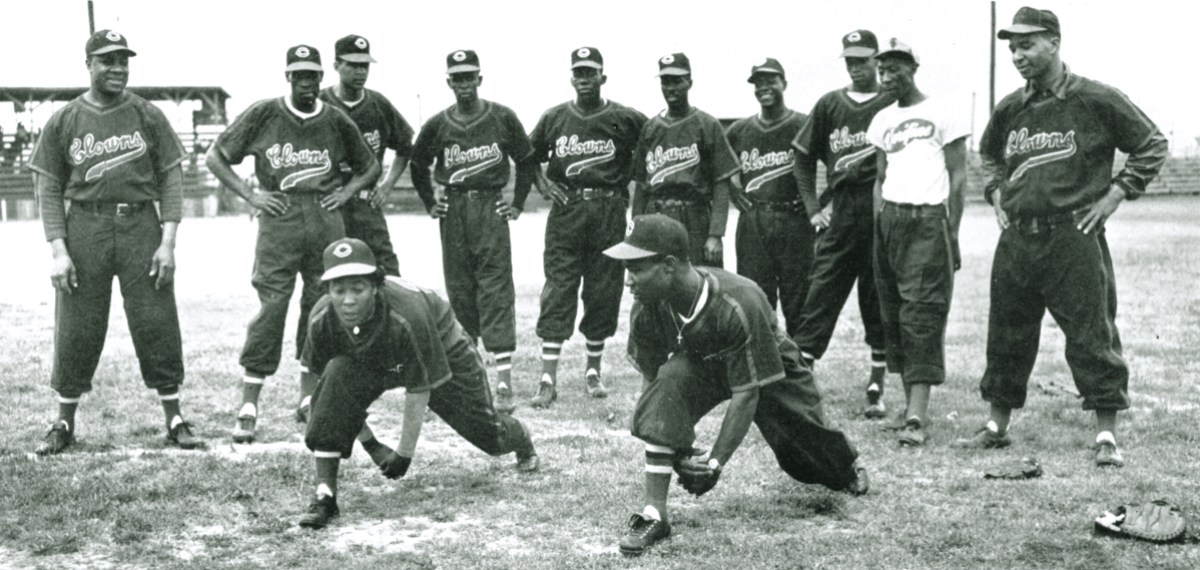
INDIANAPOLIS, IN – CIRCA 1950: Teammates on the Indianapolis Clowns of the National Negro Leagues work out in a photograph around 1950 in Indianapolis, Indiana. (Photo Reproduction by Transcendental Graphics/Getty Images)
The first season of A League of Their Own eventually sees Max becoming the second female player on a Negro League baseball team. While it’s true that women did play in the Negro Leagues, they didn’t do so until the early 1950s, after the National Negro League had already folded, following an exodus of star players and fans into the Major Leagues after it began accepting Black players. Syd Pollack’s Indianapolis Clowns (“The Harlem Globetrotters of baseball,” likely the inspiration for Red White’s All-Stars in ALOTO), were one of the four remaining teams in the Negro American league, and in 1953, Pollack signed the league’s first female player, Toni Stone, who’d already played on three semipro teams. She switched teams in 1954 and he signed two women to replace her, certain the gimmick of female players would bring more fans to the league. One of them, pitcher Mamie “Peanut” Johnson, had gone to tryouts for the All-American Girls Professional Baseball League only to realize Black women weren’t allowed to play for the league. The other, Connie Morgan, had previously played five seasons with the North Philadelphia Honey Drippers, a semi-pro Black women’s baseball team, and had written Pollack directly to ask for a tryout after hearing about Toni Stone.
Did Latina Women Play in the AAGPL?
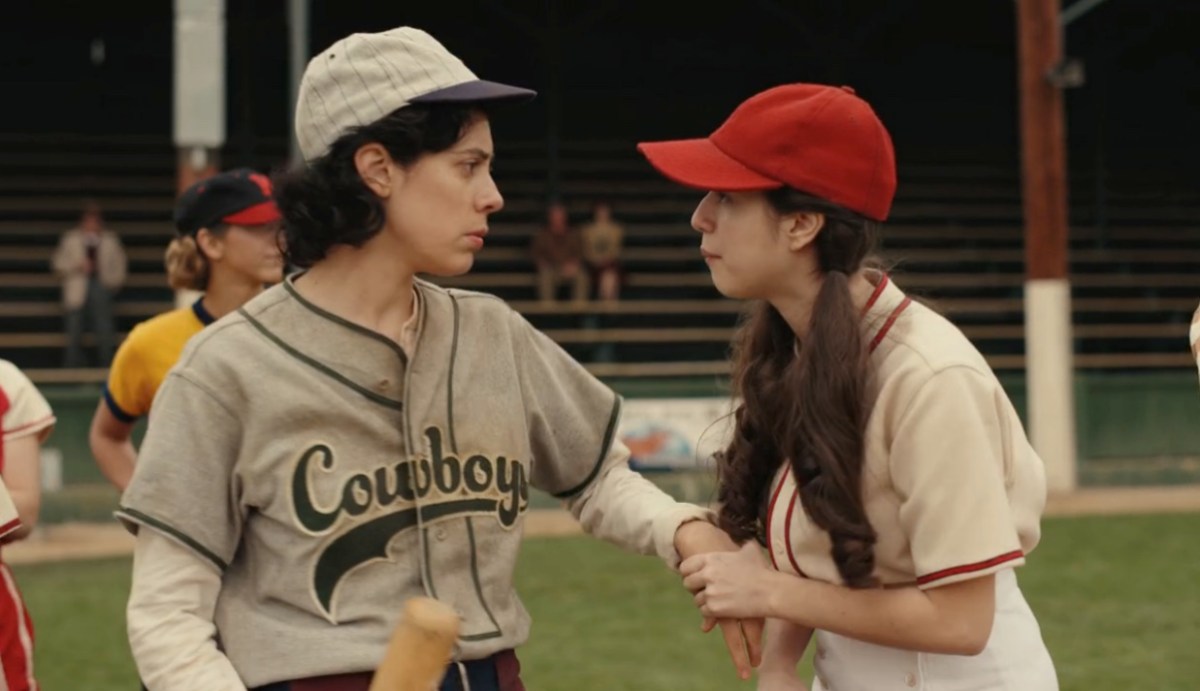
While Black women were excluded from the league, a grand total of eleven light-skinned Latina women were recruited to AAGPBL teams over the course of its existence. According to the ALOTO instagram, Lupe Garcia’s character was inspired by Mexican-American Californian AAGBPL catcher Marge Villa (who joined the league in 1946) and Esti Gonzalez by Cuban player Isabel “Lefty” Alvarez, who joined the league when she was 15 and is the subject of the documentary “Latin Nights: The Baseball Journey of Isabel Alvarez.” Like Esti, Isabel spoke limited English, and often felt lonely, isolated and homesick on her team.
Baseball had been Cuba’s top national sport since the 1870s, and the AAGPBL held their 1947 spring training in Cuba, where they scouted Eulalia Gonzeles, the first woman from Cuba to join the league. Many Cuban players felt homesick and struggled with the language barrier, inspiring some to cut their AAGPL careers shorter than expected. Isabel’s mother had to convince her to return for the 1951 season, at which point, much to Isabel’s relief, Mirta Marrero, another Cuban player, joined the Fort Wayne Daisies.
The Mexican-American community in the U.S. also had a profound love of the game, with women’s teams attracting local fans in Latine neighborhoods, often sponsored by churches and small businesses.
When the AAGPBL toured in Latin America, Villa served as her team’s interpreter.
Were AAGPBL Players Forced To Wear Skirts and Go to Beauty School?
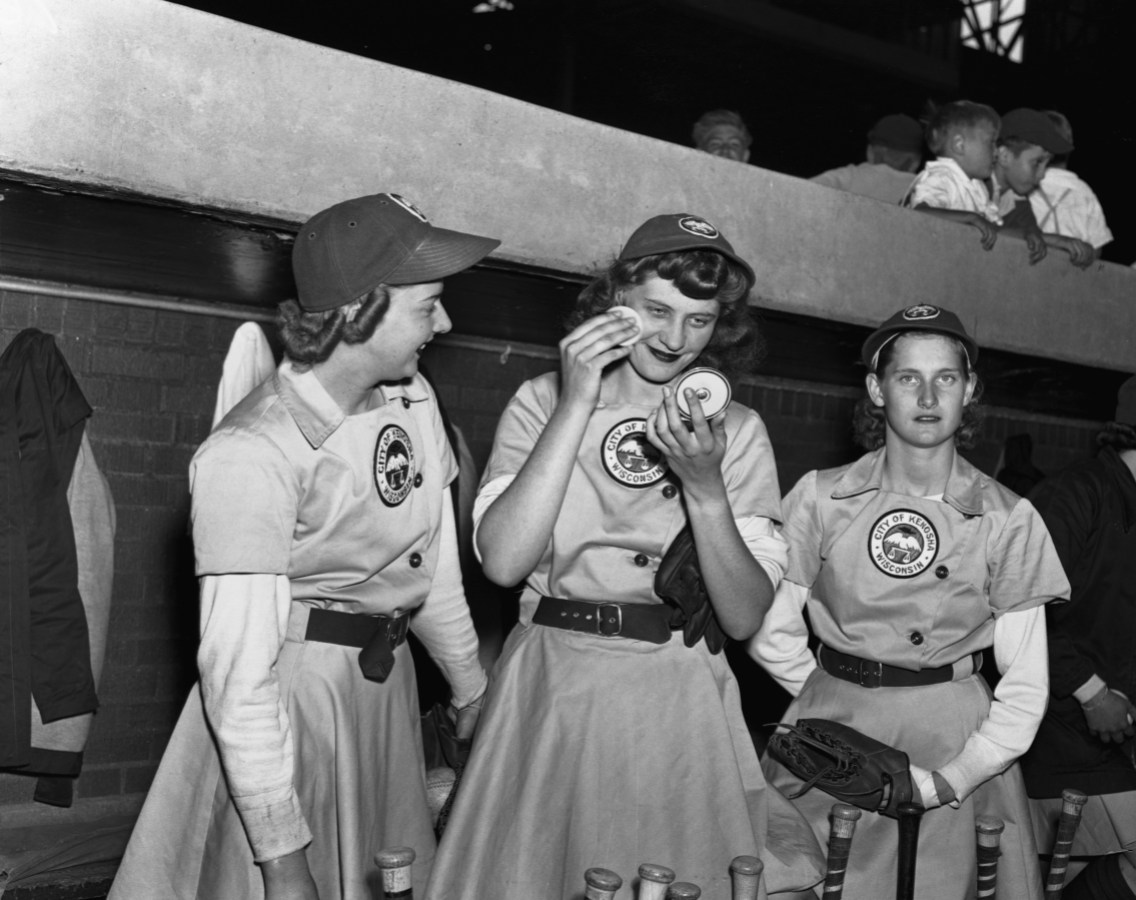
Wrigley was incredibly uncomfortable with the “mannish” women he saw on softball fields across the country and created his league “with the highest ideas of womanhood in mind… the natural appeal of women in every walk of life will be brought out in this venture. Girls will dress, act and carry themselves as befits the feminine sex.” He emphasized the intrigue and entertainment value inherent in feminine women playing a “mannish” game, the “amazing spectacle of beskirted girls throwing, catching, hitting and running like men.” They were forced to abide by strict codes of conduct, given chaperones, made to observe full makeup and beauty routines and forced to wear impractical, feminine uniforms. As in the show, a beauty mogul was brought in to whip the women into shape — Helena Rubenstein taught classes on fashion, makeup, posture and proper speech for the league’s first two years. Although players resented these restrictions and the uniforms, they also simply saw them as rules of employment and generally complied. Although the show and film frame these guidelines for femininity as essential to the league’s success, whether or not that’s true remains a matter of debate.
Were There Really That Many Lesbians in the All-American Girls Baseball League?
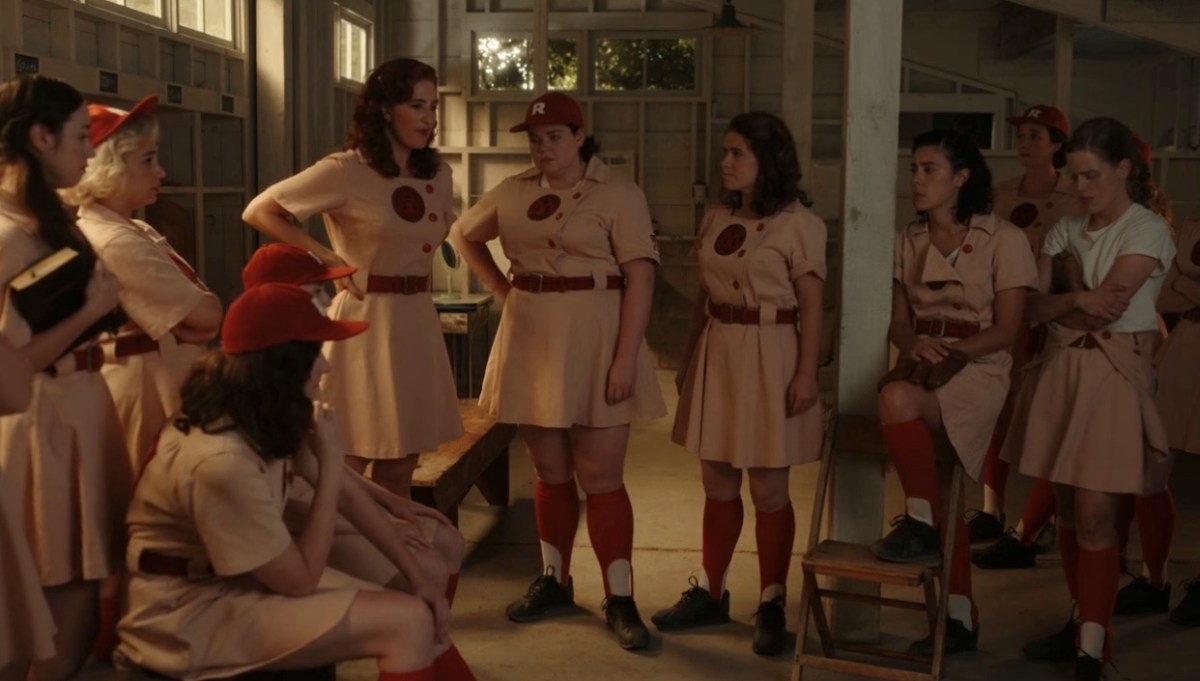
There sure were!
“The lesbian lifestyle has long been a bugbear in ball-playing circles,” writes Lois Browne in The Girls of Summer, before going on to note that “there were some lesbian players, and, chances are, chaperones. The fact of being lesbian was probably an added inducement to flee the stultifying atmosphere of their home towns and go on the ball-playing circuit.” Regardless of the sexuality composition of the sport overall, those willing and able to leave their home teams, move to a new city and travel unpredictably for several ensuing years would logically often be women without husbands or children, or women itching to get away from whatever family they did have.
According to The Hidden Queer History of “A League Of Their Own”, the league’s rigid standards of femininity were imposed in part to ensure the women were not perceived as lesbians. Rules against inter-team fraternizing were also partially rooted in a desire to stamp out romantic and sexual relationships. Managers who suspected a lesbian affair was afoot within a team would refuse to let the two continue to room together. In “Coming On Strong: Gender and Sexuality in Twentieth Century Sports,” Susan K. Cahn writes that “knowledge of gay women in sport ranged from hazy, unarticulated awareness to an informed familiarity or personal involvement. Often an athlete’s initial awareness of lesbianism developed from seeing women ‘pairing off’ or getting ‘very clannish’ with each other.”
The exact prevalence of lesbianism in the league is impossible to quantify, but the historical record is full of evidence that there was a significant percentage of queers in the league, including the two women at the center of Netflix’s documentary “A Secret Love.”
Maybelle Blair, who joined the Peoria Redwings in 1948, told the audience at a screening of A League Of Their Own, that “out of 650 [players], I bet you 400 was gay.” That’s over 60%, for the record, and ALOTO’s team is only 46% gay. Soooo take that, homophobes who think the percentage of lesbians on the Peaches is unrealistic!
“I’m very happy with what they’ve done. It’s things that Penny Marshall couldn’t say in 1992,” Blair told The Los Angeles Times. “People weren’t ready for any of this, but it needed to be told because it is the truth. These are the things that I really appreciated.”
Were There Lesbians Living Fully Lesbian Lives in the 1940s?
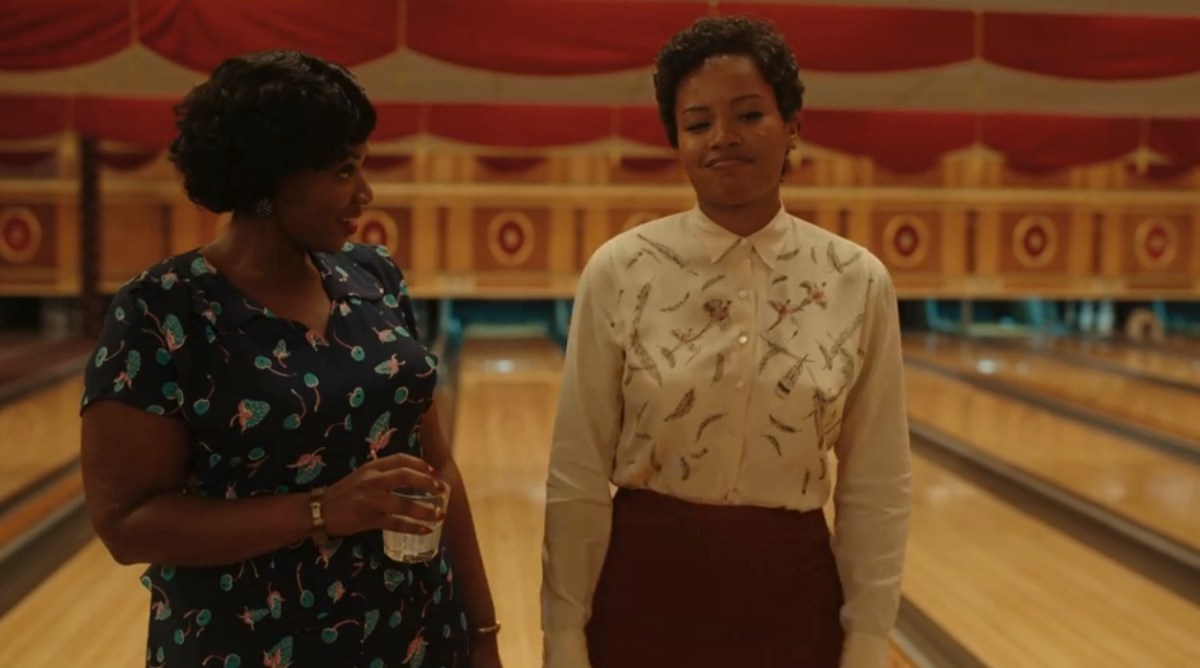
World War II was actually, relatively speaking, a pretty great time to be a lesbian, certainly better than the decades immediately before and afterwards. For a brief shimmer of time, women’s labor was necessary to the American military machine and therefore the idea that women, specifically white middle-class women, were best suited to making pies and children, went out the window. There were more jobs open to women than ever before, enabling greater economic stability without male support and the war brought women together in friendship but also “to learn to appreciate other females as serious, self-sufficient human beings,” working together in pursuits they considered important.
It also became easier for lesbians to blend in to the general population of women now that they weren’t the only ones making their own money or going to bars and restaurants with other women. There was less pressure to date. Many married queer women like Carson Shaw got a little break from their husbands. It was even okay to wear pants, since so many did so to work in factories, which enabled lesbians to more openly experiment with fashion that enabled them to spot and attract other women.
Furthermore, increased attention to “deviant” sexuality from psychologists and literature incidentally gave women the language to describe their experiences that they may have lacked in earlier decades.
All of this progress would be swiftly rolled back in the super-conservative 1950s!
Was Gay & Lesbian Nightlife in the 1940s A Thing?
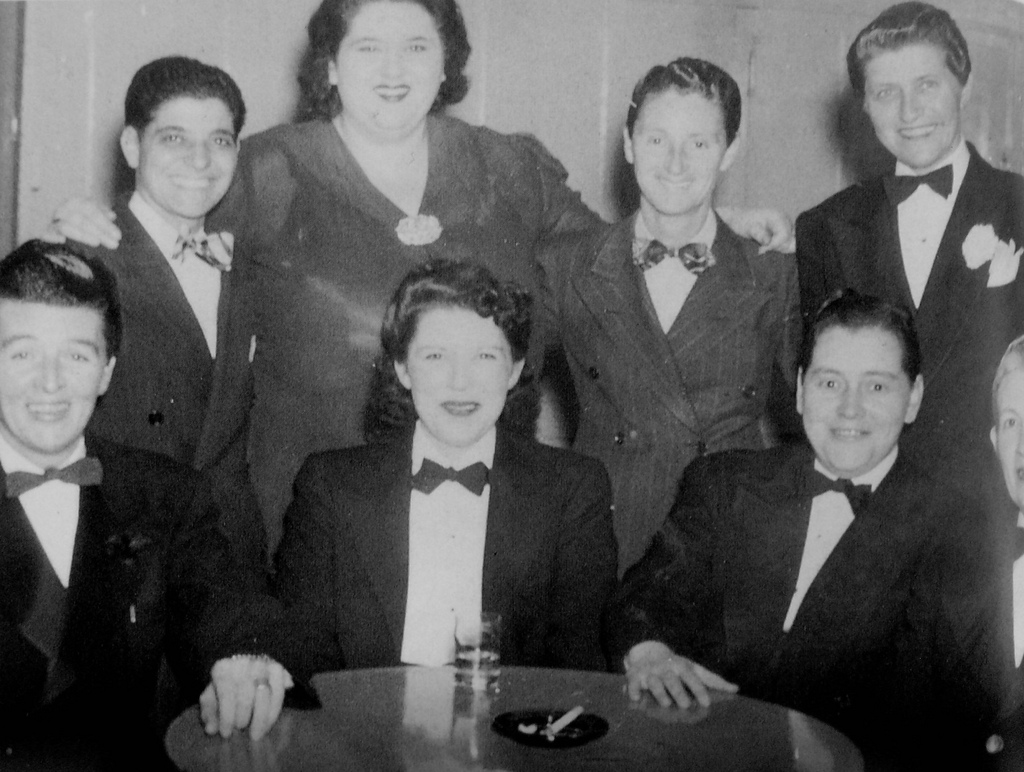
1945, Male impersonators posing at Mona’s, via Wide Open Town History Project Records Courtesy of the Gay, Lesbian, Bisexual, Transgender Historical Society.
During World War II, “increased freedom for women to defy expectations of all kinds” led to many lesbian bars opening and in some cities, “bar hopping became a favorite weekend activity, especially for working-class lesbians.” Gay and lesbian nightlife did flourish during the war, not only in gay hotspots and ports like San Francisco and New York, but also in midsize cities near military bases and factories. In Buffalo, New York, historians have verified the existence of at least 26 gay & lesbian bars during the era. Although Buffalo’s population was about five times that of Rockford’s (the second-biggest city in Illinois at the time), it’s realistic that a city Rockford’s size would be host to at least one LGBTQ+ establishment.
Series co-creators Will Graham and Abbi Jacobson told yahoo that AAGPL players they spoke to while writing the series “told us stories of sneaking out to bars and barely escaping raids,” which was ‘a reality of life for all kinds of queer people at the time, and is still a reality for people in many parts of the world now.”
D’Arcy Carden told Vanity Fair about a story Maybelle Blair shared about her first time in a gay bar: “When we asked her questions about what it was like back then, we expected her to be like, ‘It was a struggle every day, and I feared for this or that.’ But Maybelle said, ‘It was a party. I walked into that bar and I saw those other women, and I was like—oh. This is what I’ve been missing all my life.”
The possibility of raids, imprisonment, and subsequent outings through the local newspaper held different degrees of risk for different queer people, depending on race, class, employment, family situation and financial resources. The risk of patronizing gay establishments is part of the reason why these bars were generally segregated by race and class (the other part of the reason is racism and classism).
Although Black queer bars existed across the country (including bars specifically for Black lesbians), often Black queer people preferred to congregate at private house parties. Like Uncle Bertie and Gracie in A League of Their Own, Black queer couple Ruth Ellis and Babe Franklin hosted regular parties for the Black queer community at their home in Detroit, eventually called “The Gay Spot.”
Bar raids became more common in the 1950s and 1960s, and owners could often avoid them by paying off local police or by having ties to the Mafia.
In Conclusion
You should watch the show, it’s pretty gay
Non-web sources for this piece included:
Coming on Strong: Gender and Sexuality In Twentieth-Century Women’s Sport, by Susan K Cahn, University of Illinois Press,1995
The Belles of Baseball: The All-American Girls Professional Baseball League, by Nel Yomtov, Adobo Publishing, 2017
Boots of Leather, Slippers of Gold, by Elizabeth Lapovsky Kennedy and Madeline D. Davis, Routledge 1993
Girls of Summer: In Their Own League, by Lois Brown, Self-Published 1992
Latinos and American Popular Culture, edited by Patricia M. Montilla, ABC-CLIO 2013
Odd Girls and Twilight Lovers: A History of Lesbian Life in Twentieth-Century America, by Lillian Faderman, Columbia University 1991
When Women Played Hardball, by Susan E. Johnson, Seal Press 1994
Women at Play: The Story of Women in Baseball, by Barbara Gregorich, Harcourt Brace Jovanovich 1993



one of my favorite genres of online writing is “riese obsessively researches something”
Seconded! It doesn’t matter if it’s something I love or something I’ve never heard of. I always wanna read a Riese take!
Y’ALL THAT’S SO NICE AND VALIDATING THANK YOU BOTH
WOW THANKS EVERYBODY!!!
100%
Agreed! I learned so much!
Always love the outcome of Riese in research mode!
Thank you for this!
loved this!
Thank you!
This is a fascinating history! Thanks for putting it together, I really enjoyed reading it.
I really enjoyed the history and and thanks for sharing 😊😊
agree with all the commentators, i love a riese deep dive! and one on ALOTO is icing on the cake!
An amazing piece to refer to whenever someone says the new series is historically inaccurate
i absolutely needed this as i am breezing right through it
Nothing brightens my day like seeing an alert for a story by Riese with “historical deep dive” in the title!
nothing brightens my day like this comment!
I just finished watching ep6 and was happy at first and then devastated. I thought to myself: “was it really like this?” So of course i went to Autostraddle to see if if there was an article on this and Riese, you hero, you did not disappoint. Thank you so much. As soon as i have some money in my account i will donate!
well this is wonderful thank you
Riese, of the non-web books you list, is there one you particularly recommend for an engaging but well-researched read for someone (me) looking to learn more about this history?
also, I highly second Kayla’s comment!
This is a good and tough question!
So “The Belles of Baseball” I think is a middle-grade book — big text, lots of pictures, super easy to read and it gave a really nice overview of the topic which made it a great place for me to start.
“The Girls of Summer” is probably the one I would recommend because it was written by an actual AAGPBL player and it’s focused on the AAGPBL. It’s not a literary masterpiece but I think it’s the best for the experience of someone who was there but also has studied the history and done a ton of interviews.
“Women at Play” is a broader story about women in baseball of which the AAGPBL is just part of it, but is also good!
Thanks so much for taking the time to recommend a few titles! I have a feeling my public librarians are going to have a pretty good guess of what I’ve been watching…
Boots of Leather, Slippers of Gold is probably one of the best! It’s an amazing, thorough oral history of working-class lesbians in 1940s-1950s rural New York and it really gives such an absolutely detailed picture of lesbian culture at the time, strict butch/femme dichotomy lines, the importance of bar scene and culture, etc. It’s a really wonderful ethnography.
I’d also suggest reading Frankie De La Cretaz’ article that Riese mentions in this piece! It’s actually the article that inspired me years ago to want to dive into all of this research even before the show — I do a queer history podcast (History is Gay, if you want to check it out) and will DEFINITELY finally be doing a whole episode on the actual queer history of the AAGPBL!! (and hoping to talk with Will Graham about it tooooooooo)
Thank you so much for all of the hard work and research done for this article. The hateful homophobic comments I’ve seen elsewhere have been terrible. I find it hard to believe that the people threatening not to watch the show anymore because of the lesbian / bisexual content refuse to believe that these relationships existed in that era; they’ve been happening since the beginning of time they just had to be hidden from their families, friends and employers.
I agree that these relationships happened but I think Maybelle Blair got carried away with 400 of 650 players being lesbian. She seems like a nice lady but someone who likes to tell stories about how back in those days the players hit 800 foot homeruns during blizzards in July.
This was so amazing and so exactly what I needed that I finally finally joined A+. Thank you for this incredible deep dive! I learned so much and it answered all the questions I was having. 🙌
Hi!! Welcome! We’re so glad to have you!
Thank you so much for providing context from so many angles!
Just found out Marge Villa passed away a few weeks ago.